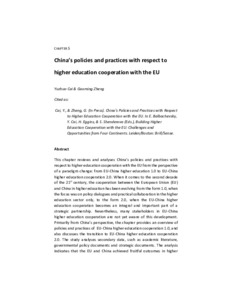China's Policies and Practices with Respect to Higher Education Cooperation with the EU
Cai, Yuzhuo; Zheng, Gaoming (2020-12)
Cai, Yuzhuo
Zheng, Gaoming
Teoksen toimittaja(t)
Balbachevsky, Elizabeth
Cai, Yuzhuo
Eggins, Heather
Shenderova, Svetlana
Brill/Sense
12 / 2020
Julkaisun pysyvä osoite on
https://urn.fi/URN:NBN:fi:tuni-202101151369
https://urn.fi/URN:NBN:fi:tuni-202101151369
Kuvaus
Peer reviewed
Tiivistelmä
When it comes to the second decade of the 21st century, the cooperation between the European Union (EU) and China in higher education has been evolving from 1.0 era, when the focus was on policy dialogues and practical collaboration in the higher education sector only, to 2.0 era, when EU-China higher education cooperation becomes an integral and important part of the EU-China strategic partnership. Nevertheless, the many stakeholders in EU-China higher education cooperation are not yet aware of such change. Primarily from China’s perspective, the chapter aims to provide an overview of policies and practices of EU-China higher education cooperation in 1.0 era, and also discuss the transition to EU-China higher education cooperation in the context of building an EU-China strategic partnership in 2.0 era. The analysis shows that the EU and China have achieved fruitful outcomes in higher education cooperation in 1.0 Era, especially in the increase of joint education provision, the deepening and expansion of research collaboration, and also the growth of individual mobility between both sides. The positive outcomes have also enhanced the compatibility of the EU’s and China’s expectations in cooperation with each other in higher education and led them into a more comprehensive partnership development in 2.0 era, fitting into the EU-China strategic partnership framework. The chapter also highlights that the recently launched China’s New Silk Road Policy has brought in a new perspective in the current landscape of international higher education cooperation and may affect the EU-China higher education cooperation in the future. The study applies an on-desk qualitative research method by analysing secondary data, such as academic literature, governmental policy documents, and strategic documents.
Kokoelmat
- TUNICRIS-julkaisut [16977]
